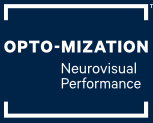Brain Injury & Neuro Optometry
When most people think of brain health they think of having an MRI to see the parts of the brain. An MRI of the brain can show larger-scale physical damage to areas, but most MRI’s can’t show the type of damage sustained in a concussion, mild traumatic brain injury (mTBI), or other brain injuries.
Brain Injury & Neuro-Optometric Rehabilitation
When most people think of brain health they think of having an MRI to see the parts of the brain. An MRI of the brain can show larger-scale physical damage to areas, but most MRI’s can’t show the type of damage sustained in a concussion, mild traumatic brain injury (mTBI), or other brain injuries.
A neuro-optometry evaluation involves measuring and examining how the eyes and the brain work together to see if there are areas of dysfunction that are causing symptoms.

There are several key areas that need to be assessed:
Oculomotor function (eye tracking)
Saccadic (eye movement) abilities have been shown to be affected by concussions, and problems with oculomotor function has been shown to be an indicator of brain injury. These should be tested both with targets in real space, and often with computerized eye tracking. Problems with saccades are often diagnosed as oculomotor dysfunction or saccadic dysfunction.
Accommodation (focusing)
Accommodation ability is measured by using lenses to determine the ability of the brain to control how and where the eyes are focusing. Problems with accommodation are often diagnosed as accommodative infacility or accommodative dysfunction.
Binocular function (eye teaming)
Convergence (eyes moving inwards) and divergence (eyes moving outwards) abilities need to be assessed. The most important tests for these abilities involve using prism to measure the ability of the eye to work together. Problems with convergence or divergence are often diagnosed as convergence insufficiency, convergence excess. Divergence insufficiency, divergence excess, vergence dysfunction, or binocular dysfunction.
Stability of binocular function also needs to be assessed. If the eyes do not maintain stable alignment it can lead to many post-concussion symptoms. This can be measured with a variety of devices. Problems with stability are often diagnosed as unstable fusion, unstable fixation, or binocular dysfunction
Dr. Cameron McCrodan answers your questions about Eye floaters coming and going post-head trauma/brain injury. Is that normal or curable?
Depth perception and spatial processing
Depth perception can be measured in a variety of ways. One of the ways this is measured is by using polarized 3D glasses and 3D targets. This does not always rule out problems with depth perception because it only looks at one aspect.
Depth and spatial perception can also be tested by using various tests that are in real-space. Problems with depth perception are often diagnosed as reduced depth perception or reduced stereopsis
Peripheral integration/awareness
Our central visual system is what our brains use for seeing clearly and identifying what we are looking at. Our peripheral visual system is what our brains use for processing movement, motion, guiding eye tracking, balance, coordination and more. This can be seen very quickly if you cover both your eyes entirely except for a very small pinhole of vision, and then try to walk around your house. Peripheral integration is different than just visual field testing, which only tests if you can see it, not whether it’s being processed accurately. This is best tested with a series of functional balance and head movement testing with your optometrist. Problems in this area can often be diagnosed as visual-vestibular mismatch or poor central-peripheral integration
Visual acuity (how small of a target that can be seen)
Visual acuity is tested on most routine exams. Visual acuity, and the glasses prescription required to see clearly is often the focus of most eye examinations. It can often be quite frustrating for people who feel like their vision is part of their post-concussion syndrome, but after having their prescription and eye health checked, they are told their vision is ‘fine’. Visual acuity and prescription is the testing done where you have to see the small targets and different lenses are used (“better one, or better two”) to determine what prescription allows for the best clarity. A common problem is that the way prescriptions are usually measured and given can result in glasses or contacts that actually contribute to post-concussion symptoms. Specialized testing for glasses prescriptions post-concussion should factor in how the glasses affect balance, dizziness, headaches, migraines, light sensitivity, screen tolerance and more. We often refer to this as Ergoptics™ prescribing.
Visual-vestibular integration (how the eyes and inner ear work together)
Our brain is constantly comparing our visual and vestibular inputs. Certain vestibular problems such as BPPV (benign paroxymal positional vertigo) should be addressed before vision is tested. However, vestibular rehabilitation is often dependent on proper visual function, and people will often have trouble with vestibular rehab, or plateau in their recovery if their vision is not working properly. This is often tested by using various lenses to change how vision is being processed, and then testing the visual-vestibular integration through balance tests and head movement (dynamic visual acuity). Problems with visual-vestibular integration are often diagnosed as a visual-vestibular mismatch.
Part of the examination process should also be counseling on various treatment options.
